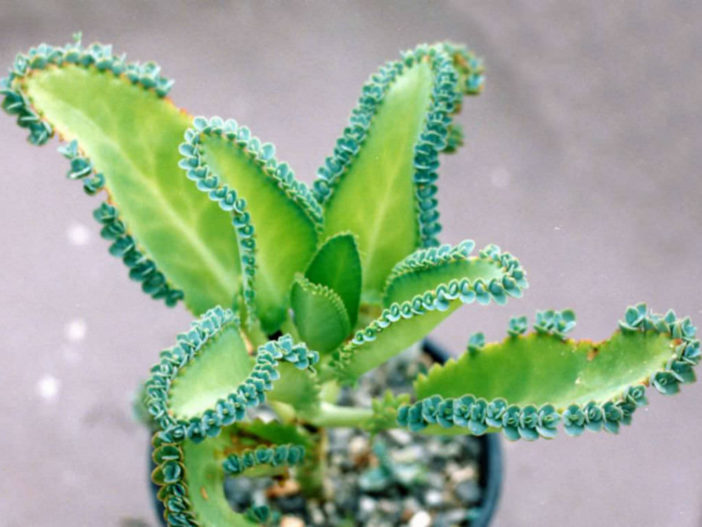Scientific Name
Kalanchoe laetivirens Descoings
Common Name(s)
Mother of Thousands, Mother of Millions
Synonym(s)
Bryophyllum crenodaigremontianum, Bryophyllum crenato-daigremontianum, Bryophyllum laetivirens, Kalanchoe crenato-daigremontiana, Kalanchoe daigremontiana 'Green Form', Kalanchoe × laetivirens
Scientific Classification
Family: Crassulaceae
Subfamily: Sedoideae
Tribe: Kalanchoeae
Genus: Kalanchoe
Description
Kalanchoe laetivirens, also known as Bryophyllum laetivirens, is an unusual succulent with a simple stem and large, green to bluish-green leaves with baby plantlets all around the round-toothed edges, giving them a dainty, unique appearance. It grows up to 8 inches (20 cm) tall. The leaves are oblong to elliptic, up to 6 inches (15 cm) long and 2.8 inches (7 cm) wide. Flowers are greenish-white or greenish-yellow, tinged with pink to purplish-pink. They are bell-shaped and appear in many-flowered, up to 8 inches (20 cm) tall, corymbose cymes in early spring.
This species is similar to Kalanchoe daigremontiana but differs characteristically in its growth habit and the color and form of the leaves.

Hardiness
USDA hardiness zones 9a to 11b: from 20 °F (−6.7 °C) to 50 °F (+10 °C).
How to Grow and Care
Kalanchoe care is minimal but be cautious about light levels. Intense sunlight can burn the tips of the leaves. Place pots in partial sun to light shade areas when growing Kalanchoes.
The flowering varieties are highly rewarding for their colorful and long-lasting flowers. They prefer bright, sunny locations, especially in the growing season. Water moderately from fall to winter when the growth is most active. Reduce watering during the hottest summer months when the plants are mostly dormant and winter when the growth slows down significantly. Let the soil surface dry out between waterings. Watch the fleshy leaves for signs of water distress. An ordinary potting soil mix is fine. Feed bi-weekly during the growing season with a liquid fertilizer, or use slow-release pellets.
These small plants require repotting every few years. When repotting, take additional care in handling as the leaves are somewhat brittle and can snap easily. Clay pots work exceptionally well for planting Kalanchoes. Ensure pots can drain well and saucers can empty easily.
Learn more at How to Grow and Care for Kalanchoe.
Origin
Kalanchoe laetivirens is native to Madagascar. Some authors suggest that it is a natural hybrid resulting from the cross between Kalanchoe daigremontiana and Kalanchoe laxiflora, but no experimental evidence has been provided to support this claim.
Links
- Back to genus Kalanchoe
- Succupedia: Browse succulents by Scientific Name, Common Name, Genus, Family, USDA Hardiness Zone, Origin, or cacti by Genus
Photo Gallery
Click on a photo to see a larger version.



